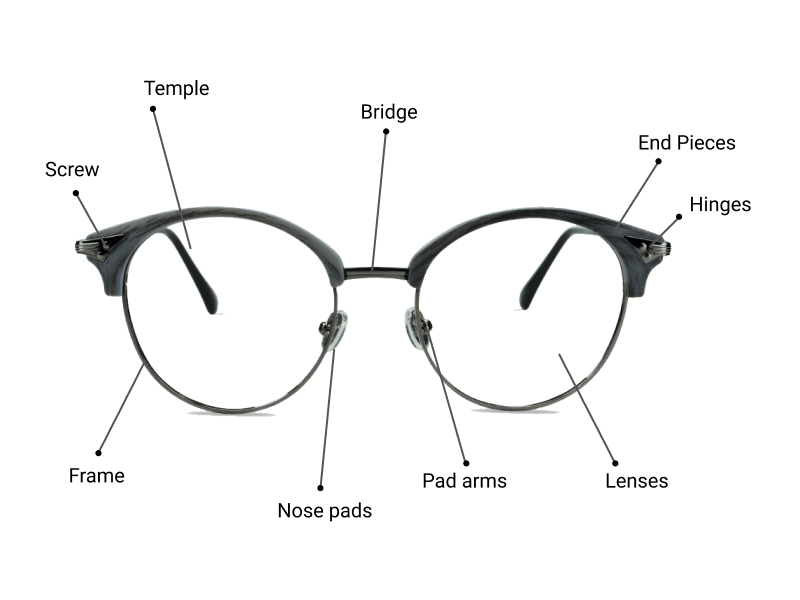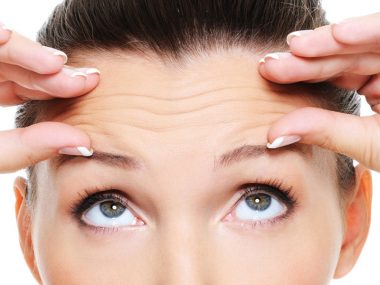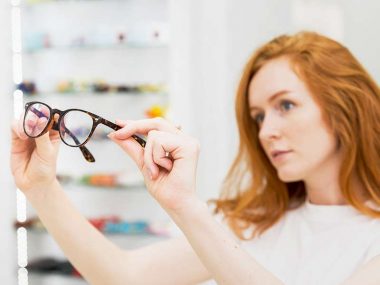Not all of us are Opticians but we should know what we are wearing! People here can understand the importance of eyewear and all the fashion related to it. Well, today our subject is not about fashion, instead, we’re going to give you useful information about elements of eyewear. Many of you must be thinking that there is no need to know about eyeglasses except their lenses but it is very important to know at times when it comes to explaining the problem to your optician or to attending any special event.
With that spirit, this guide will target the nine essential components that make eyeglasses. Keep reading to know the complete anatomy of eyeglasses and their functions to support your vision.
Frame:
An iconic part of eyeglasses, frames give the right shape and structure to hold lenses together. Armed with the eye prescription, choosing the frame type is the first thing to consider while buying glasses.
Frames are available in a variety of colors and shapes to provide a different look and feel. You have to choose the one that suits your style and prescription needs.
Types of the front frames:
There are 3 types of Front Frames
Full Rim
In Full Rim, the lens is packed with the rim all over the lenses and aids in your vision through a certain suitable angle called lens groove.
Half Rim
In this type of glasses, the lenses are covered with the Rim only from the upside and the lower side remains open. To support the glasses, there comes a thin nylon cord called ‘Supra’.
No Rim/Rimless
In the case of the rimless front frame, the frame and lenses are attached with a screw. And so it is a very important and delicate frame. Such frames are evergreen and will always stay in the trend.
Lenses:
Lenses are undoubtedly the most important part of eyeglasses. Mostly a transparent piece of glass, plastic, polycarbonate, or other material, they help you in your vision requirement. Notably, these parts of glasses are specially customized and crafted according to your prescription needs.
Lenses come with a variety of features such as anti-glare, progressive, blue light blocking to suit your unique preferences.
Types of lenses:
Depending on your prescription needs, a material used, and preferences lenses are categorized under the bifocal, prescription reader, ready reader, varifocal, polycarbonate, trivex, etc
Related article – Best Choice of Lenses for your Glasses
Temple:
The long stems that extend from the frames are called the arms or temples of the eyeglasses. This is a part of the glass that secures them on faces and keeps them on ears.
Besides the temples, there are temple tips. Standing at the edges of temples, they provide extra comfort to the skin against metal irritation.
Temple subtype:
Based on shape, temple types are categorized as blade temple, curl side, drop end, hockey end, paddle temple, uni piece temple.
Bridges:
The parts of glasses that make contact with your nose are bridges. While supporting a large amount of weight of your glasses and connecting both lenses, they also determine the comfortable fitting of eyeglasses.
Types of bridges:
Regular bridge:
The simple and most convenient design of bridges makes a U shape slot on the frame front.
Keyhole bridge:
A classic-style bridge that resembles the shape of a keyhole.
Metal bridge:
Especially used in rimless and split frame style, where a metal piece is used to join two lenses together
Hinge:
Also known as joint, hinge function is to provide temple movement. They are generally made of metal and fitted with a small screw that enables you to easily close and open the temples, meanwhile keeping them connected to the frame front.
Today many glasses have flex or spring hinges that allow arms to move more freely and avoid the risk of breaking.
Types of hinges:
Typically glasses hinges are divided into three types:
Barrel or standard hinges:
The most popular hinge designs are simple to repair and maintain.
Spring hinges:
A more flexible and popular option in hinges, best for those with an active lifestyle.
No hinges:
Hingeless design is a recent trend in eyewear with no screw, barrel, or hinges. Offering great mobility and flexibility, they are ideal for kids’ glasses.
Endpiece:
The outermost portion of the glasses is the end piece. Located on the rear side of frames, this is the smallest part that connects the hinge to the front of eyeglasses.
Furthermore, the style and size of the endpiece can vary depending on the style of the temple you have in your glasses. Different types of endpieces are- full rim end piece, half rim end piece, and rimless end piece.
Nose pad:
Nose pads on the glasses are little humps or circular pads that keep glasses comfortable on the nose. There are different styles of nose pads. However, their primary function is to provide a better fit to glasses, so they do not fall off from the wearer’s face.
Nose pad subtype:
Screw-In nose pad:
The type of nose pad is attached to pad arms with a small screw.
Push in nose pad:
The nose pads are attached to the frame with a small rectangular opening.
Clip-on nose pad:
Also known as Crimp-on, the type of nose pads wrap around the pad arms and are supported on a frame with the rear flaps.
Pad Arms:
A small piece of metal that holds the nose pad is called pad arms. Typically they are adjustable to fit the structure of your nose.
Screw:
A small metal faster generally made of steel, zinc, and iron is a vital component of eyeglasses that significantly brings different parts of your eyepiece together.
Screws are generally inserted on hinges to join temples and frame fronts. While connecting both the parts, they bring mobility and stability to temples.
Screw subcategories:
Dowel screw: uses a straight slot on top of the screw head.
Crosshead screw: uses a cross-shaped slot in the top of screw head:
Thread seeking screw: screw placed on the top tenon of hinges.
Tips for Eyeglasses
Tip 1: Take Care of Nose Pads
Nowadays, comfort has become the biggest priority and eyewear is no exception. Nose pads help you in adjusting the frame on your eyes coordinating with the nose. So it is vital to keep it clean and do not bend it unnecessarily.
Tip 2: Remove Your Glasses While Sleeping
Many people who wear spectacles have the habit of sleeping along with glasses but that could damage your frame or lens during any awkward position of sleeping. So you should remove the glass before going to bed.
Tip 3: Clean them regularly
Cleaning the frame is important since the frame is constantly touching your skin. Are you new to glasses, let us know how to clean glasses properly.
Now when you seem to understand all the unfamiliar terms and important parts of eyeglasses, it’s time to start shopping for the new pair. All these parts function perfectly, to give you a comfortable glass-wearing experience. To know more about the parts of glasses and their purpose, please get in touch.







